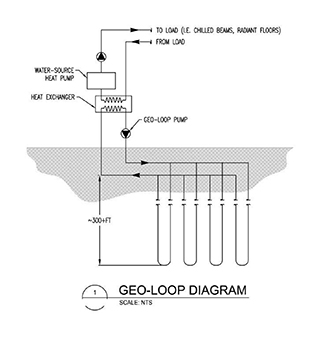|
Subscribe / Renew |
|
|
Contact Us |
|
| ► Subscribe to our Free Weekly Newsletter | |
| home | Welcome, sign in or click here to subscribe. | login |
Environment
| |
 |
May 31, 2013
Greenfire ready to generate environmental dividends
PSF Mechanical

Whitmyre
|
Synergy is a word not often associated with mechanical systems. But that is in fact the case at Greenfire Campus where the “sensibly sustainable” approach was our benchmark for assessing performance criteria and comfort levels.
Is it sensible to cool a building to 70 degrees on a 95-degree day, or is 80 degrees OK? Is it sensible to spend significant funds on a boiler to provide that extra margin of heating for the coldest 35 hours a year, or is there a more practical solution?
Blending fire, water
In the elements, water and fire are separate. At Greenfire we’ve mixed it all up. Water and fire merge together to form our heating, ventilation and air-conditioning (HVAC) system.
The campus will use a hydronic system that heats or cools water at a central location before distributing it throughout the buildings — exchanging heat for cool, and back again. Deep in the ground lies the heart of this collaboration: a ground-coupled geothermal loop that feeds water-source heat pumps, which in turn feed the hydronic HVAC systems in the office and residential buildings, a shared system.
With WSP providing early conceptual guidance, PSF Mechanical’s design-build team developed systems that best use the energy Mother Nature provides: the relatively constant temperature of the ground below us.
Below 10 feet, the earth’s temperature is generally around 50 degree Fahrenheit. When the ambient temperature falls below the ground temperature, heat pumps extract heat from the ground and use it to heat the building. When the ambient temperature of a building exceeds that of the ground, the reverse happens and the heat pumps transfer excess heat back into the ground.
Since Seattle’s weather is typically cool for the majority of the year, the buildings will be heated more often than not. With this geothermal system pulling heat from the ground much more often than returning it, the ground must be “recharged” with heat.
A synergistic solution to recharge the ground was created by using solar heat from the residential domestic hot water system. Any time the domestic hot water storage tanks reach capacity, solar heat is diverted into the geothermal loop. This keeps the ground temperature in an efficient range of operation to supply the heat pumps, and avoids overheating the solar panels.
Without this convenient location to reject excess heat, it would be released into the atmosphere and wasted.
Daylighting, solar systems
As Seattle residents know, daylight is like gold, especially during the winter. Greenfire provides ample daylighting through thoughtful window placement that reduces the need for electric lighting during the day. This same principle is applied to the heating and cooling demands in the office building through the use of high-performing glazing and insulation systems. Priority is given to natural ventilation over mechanical heating and cooling of the spaces.
For the apartments, solar thermal panels on the roof will be used to generate up to 70 percent of the annual hot water needed for everything from showers to washing dishes. An innovative coating on the solar collector surfaces gathers heat even in overcast skies. So yes, it works well even in Seattle.
And when heat is needed, water-source heat pumps provide warm water to radiant floors. The direct warmth radiated allows for a lower heating temperature set-point, further saving energy.
The mechanical systems were designed to recover energy that would have been wasted. Warm air exhausted from kitchen and bathroom vents is used to heat fresh air as it is brought into the building by heat recovery ventilators. The result is superior indoor air quality while using less energy.
Mechanical systems are monitored and controlled by a central direct digital control network provided by ATS Automation. The network is in command of all systems, allowing for the optimization of the exchange of heat from system to system and building to building.
This central command also allows for a convenient place to collect energy usage data that can be shared with the occupants and used to find additional energy savings.
These sophisticated mechanical systems created the opportunity to pursue credits for enhanced systems commissioning as part of LEED certification. Commissioning is an in-depth verification process that confirms the systems are performing as designed. This effort, orchestrated by Keithly Barber Associates and executed by PSF’s in-house commissioning technicians, will assure that the building systems and the occupants can work together in the synergistic fashion envisioned for this model project.
At PSF, we believe buildings with efficient envelopes that are designed to create a portion of their own energy will see favorable payback periods in our environment. Beyond that, as energy costs rise, these buildings will reap increased dividends.
Chris Whitmyre, PE, LEED AP, is PSF Mechanical’s project executive on Greenfire. His three decades of mechanical experience includes 10 years on the Washington State Building Code Council’s Technical Advisory Group, and Energy Code group.
Other Stories:
- Green campus fires on all sustainable cylinders
- Energy use? Other buildings are green with envy
- Green vision carries over to the construction process
- Sharing space with nature in the city
- Urban agriculture blossoms in Ballard
- Are you ready for some urban farming?
- A Look Around



